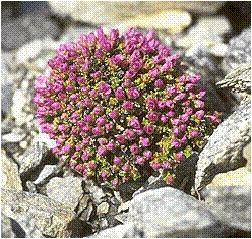
People, plants and animals can adapt to living in extreme environments. Let's look at a few methods...
Animals
(fauna)
The caribou has two layers of fur to keep warm, large hooves to help it travel over difficult ground and small hairs in the nostrils to warm the air as they breath. The polar bear has thick layers of hollow fur to trap heat, stiff hairs on their feet to help with traction and light coloured fur to camouflage them when hunting. The Arctic fox has a superb metabolic rate and can keep moving and hunting in minus 50 degree temperatures, its fur helps to camouflage them and they can jump and break the ice to hunt for food underneath.



The bilby is nocturnal so only comes out when it is dark which helps to reduce water loss, it has low water needs and burrows underground for coller conditions. The red kangaroo feeds at dawn and dusk and sleeps during the day which helps it to avoid the extreme heat, it gets a lot of its water needs from dew (it licks dew from plants) and it hops which is far more energy efficient than running. The perentie lizard gets most of its water needs from the food it eats, it hides in rock crevices as it is cooler and it hibernates during winters (which are warmer in Australia!).



Plants
(flora)
The Arctic poppy is low growing to help it stay out of the wind and the leaves stay green all year to aid with photosynthesis. The Arctic willow has small fuzzy hairs to help insulate against cold temperatures and it produces a pesticide to deter predators. The Saxifrage has deep, thick roots which store water and carbohydrates, it produces a natural antifreeze and creates many seeds to help its reproduction.



Drought avoidance plants only survive one growing season so they avoid the droughts, they germinate rapidly and the seeds last for years, only growing when there is enough water. Drought tolerant plants have deep and extensive roots to get water, they have waxy leaves to prevent moisture loss and can photosynthesise with very low amounts of water. Succulent plants have extensive but very shallow roots to absorb water before it gets deep underground, they close stomata during droughts to prevent water loss and they have toxic spines to prevent predators from eating them.



People
People adapt by changing the buildings they live in, their farming methods and the clothes they wear.
In hot arid environments people have solar panels on the buildings to generate electricity, the buildings are raised from the ground to allow air to blow through to keep it cool and light colours are used in order to reflect heat. In cold polar climates buldings are built off the ground so any heat doesn't melt the permafrost, they have small windows to reduce heat loss and they have a fuel and supply store nearby.


In hot arid environments people get water from underground to help grow crops and for drinking, they are nomadic (which means they move around) and they wear loose fitting, light coloured clothes. In cold polar climates people hunt as a community and share what they kill, they use the heat from underneath the Earth to create energy (geothermal heat) and they wear thick clothes and fur often made from animal skin.




